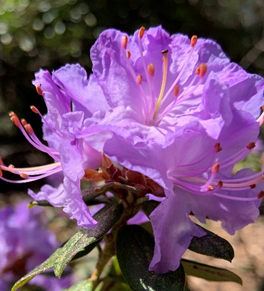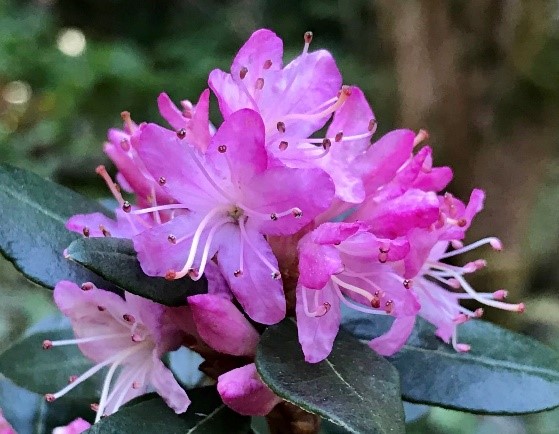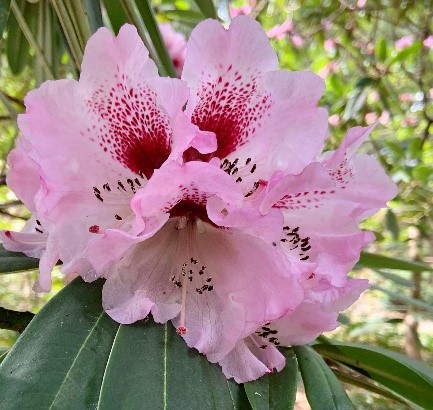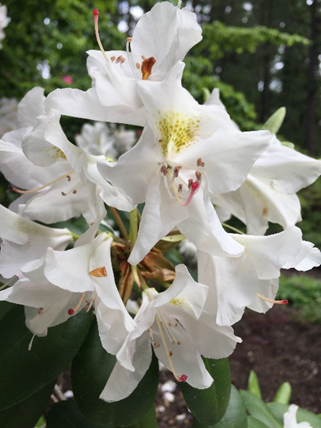Living in the Pacific Northwest, almost everyone is familiar with the Rhododendron. These shrubs are used extensively in both public and private gardens probably because the PNW has an ideal climate for these “king of the shrubs” as they are often regarded because many consider them to be the best flowering evergreen plants for the temperate landscape. So popular in our area, it is even the state flower of Washington. But there may be a few things you don’t know.
Did you know the name Rhododendron comes from the Greek words “rodon” which means “rose” and “dendron” which means “tree”, hence “Rose Tree”? Have you noticed the size of some of the rhododendrons in the Woodland Garden? There is good reason to call them a tree. While some rhododendrons stay shorter than a foot tall, some can grow up to 100 feet tall.
The family (Ericaceae) into which the genus Rhododendron fall, also includes mountain laurels (Kalmia), Enkianthus, Pieris, huckleberry (Vaccinium), salal (Gaultheria shallon), sourwood tree (Oxydendron) all of which are located in the Woodland Garden.
While many rhododendrons seem to have similar leaves that are dark green and elliptical in shape, there is actually a wide range with many shapes, colors, textures and sizes that can add interest to the garden at any time of the year. There are even a few rhododendrons that have variegated leaves, like Rhododendron ‘President Roosevelt’ (W33). The underside of some rhododendron leaves are covered with a brown or silver fuzz, called indumentum, which helps protect the leaves from water loss and extreme temperatures. Look around the Woodland Garden and see if you can find interesting leaves such as those of Rhododendron smirnowii (W20) and Rhododendron yakushimanum (W20), which both have leaves decoratively felted with white to silvery hairs. Or look for Rhododendron ‘Daphnoides’ (W27) that has dark green convex leaves that look quite different than most rhododendrons.
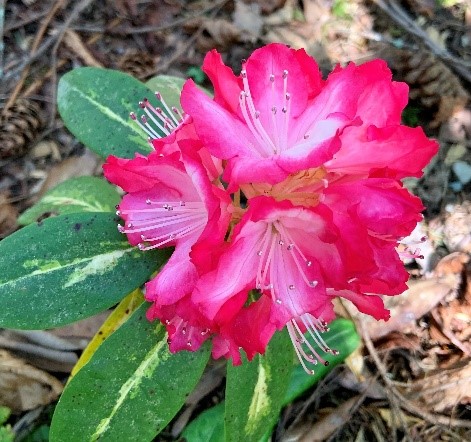
Did you know that there are more than 1000 different natural species of Rhododendron? The wild types, called species (as differentiated from hybrids), are native to the temperate regions of Asia, North America, and Europe, as well as to the tropical regions of southeast Asia and northern Australia. That’s all of the world’s continents except Africa, South America and Antarctica.
Most of the rhododendrons that people grow are hybrids, rather than natural species. Rhododendron species as found in the wild grow, flower, are pollinated, and set seed. The seedlings are usually pollinated by the plants of the same species and generally look similar to the parent plants, though there may be small, and sometimes considerable, variations among them. But they remain the same species.
Hybrid rhododendrons, on the other hand, are plants resulting from the cross-pollination of one species with a different species or hybrid. When this happens, the offspring may look quite different from either parent. Instead of the Latin names given to natural species, hybrids are named in the vernacular, such as ‘The Honorable Jean Marie de Montague,’ ‘Cynthia,’ and ‘Unique’ (all of which can be found in the Woodland Garden). The purposes for hybridizing can be various: larger flowers, different forms with different colors, larger flowers that are more cold or heat tolerant, etc.
One question that often pops up when talking about rhododendrons is “What is the difference between Rhododendrons and Azaleas?” The easy answer is that all azaleas are rhododendrons. The genus Rhododendron includes both rhodys and azaleas which are used as common names. Other distinctions between them are made by botanists or gardeners. Azaleas are a subgenus of Rhododendron and are distinguished from “true” rhododendrons by having only five anthers (the pollen-bearing part of the stamen in a flower) as opposed to ten or more. Other differences are that Rhododendron plants are usually evergreen while azaleas are usually deciduous, although there are a few evergreen azaleas. Some recognize azaleas because they don’t have flower trusses like Rhododendrons but of course, there is an exception, the Homebush Azalea which have a tight ball shaped truss. (Look for this azalea in the woodland garden). Rhododendrons have large, paddle-shaped leaves and large, bell- or funnel-shaped flowers while azaleas have small, elliptical leaves and trumpet- or tubular-shaped flowers. Of course, there are exceptions (sounds like the English language?). Rhododendrons are erect, growing up to 80 feet high, while Azaleas are more twiggy, spreading bushes, usually reaching a height of no more than feet.
Another thing that people may not know about rhododendrons is that they do not need to be planted in deep shade. In fact, this often results in plants that have very few flowers. Light is the primary factor that stimulates flower bud development. Rhododendrons should be planted where they receive sufficient light so that the plants set flower buds, but not in too sunny a location that leaf damage occurs.
So, you may have thought you knew rhododendrons, but hopefully you will discover a little bit more which will lead to a new appreciation for this ubiquitous plant.

